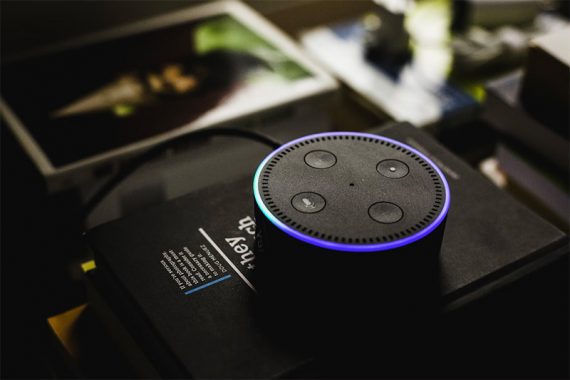Retailers of any size can offer voice notifications via Alexa, Siri, Google, and similar assistants, potentially building customer retention in an Amazon-like manner.
Imagine a shopper with an Amazon Echo device. When FedEx or the United States Postal Service delivers an order, a yellow light on the Echo notifies the shopper, who inquires with Alexa. “Your Amazon order of coffee has arrived,” Alexa responds.
This verbal notification is valuable to Amazon in at least a couple of ways. It announces the company’s name, Amazon, elevating the brand. And it shares a helpful message in a convenient format, strengthening its relationship with that customer.

The Alexa Echo Dot is one of the most convenient ways to notify shoppers of a delivered order.
Moreover, a shopper seeking the status of an outstanding order can ask Alexa for an update. And finally, automobiles now include Alexa (and other voice assistants). A driver can request an order status or even purchase an item during a commute.
Retention
Shilp Agarwal is CEO and co-founder of Blutag, a SaaS platform for building retail voice apps. He and others hope the medium can grow to facilitate a complete buyer’s journey. Yet notifications alone are one of the best entry points to test the channel.
Think of it this way. Customer acquisition and retention are pillars of ecommerce growth. A merchant or direct-to-consumer brand must first acquire customers and then work to retain them. Acquisition tactics typically include advertising, content marketing, and search engine optimization. Retaining those customers focuses on lifecycle marketing, more content marketing, and the overall experience. Voice notifications can address this third aspect of customer retention — the shopper experience.
Customer acquisition might be the most enjoyable part of online retail marketing. Acquisition can feel like a money-making machine — find a channel such as Meta Ads that consistently drives profitable sales at a fast and furious pace.
Many digital brands generate nearly all of their revenue via a paid acquisition channel. Invest more, and profits accelerate — a revenue racecar.
Customer retention is less flashy, but it too is a steady growth channel with unique benefits. For one, marketing to customers is less expensive than acquiring them. The cost of generating a sale from a series of ads is almost certainly higher than from an email or text messaging list.
Moreover, loyal shoppers spend more. Depending on the source, such as a decade-old Adobe report (PDF), repeat shoppers have a three- to five-times higher average order value than new buyers.
Finally, a business that retains customers can invest more in acquiring new ones. This is vital in highly competitive markets.
Voice Notification
In this context, a simple delivery notification can help a retailer or brand, like it helps Amazon. The brand gets its name repeated aloud, potentially increasing recognition and reminding the shopper of the store and its products. And buyers appreciate the convenience.
Shopify stores can use Blutag’s free app to enable Alexa notifications. Other stores can engage a developer to connect to Alexa and similar assistants via an application programming interface — the Alexa Voice Service API, for example. This is an achievable (although not easy) do-it-yourself project, on par with other forms of application development.
Once it sets up voice notifications, a business can measure the impact on customer retention. This progression is something Agarwal described. He founded an online store, Szul Jewelry, in 2000. The business flourished. But when The Great Recession hit in 2007, acquiring customers was much more difficult.
“It was at that point that I started to focus on customer retention,” Agarwal said. “Acquisition costs were unpredictable, but we had [existing] customers, and if they made a few extra purchases, we could increase their lifetime value.”
At the time, Agarwal turned to lifecycle marketing. A shopper who bought an engagement wedding ring would receive an email pitching the entire set. Buy a wedding ring set, and you would see an email touting gifts for the bridal party.
This experience focused Agarwal on customer engagement and interactions beyond a web browser.
Getting Started
Try to learn if shoppers who receive voice notifications purchase again at a higher rate than others. Consider offering back-in-stock notifications to customers who ordered those products. Then experiment with other interactions. Combine a follow-up text with the voice notification to build lifecycle experiences.





